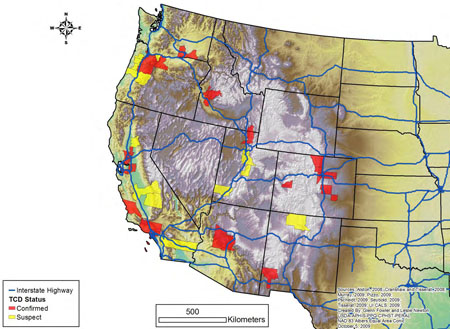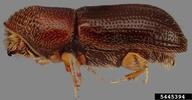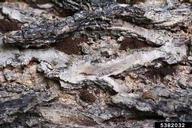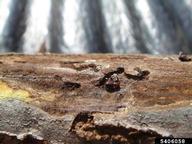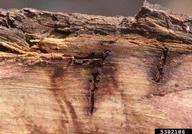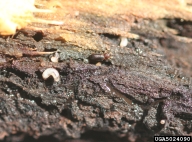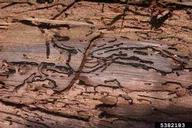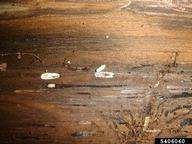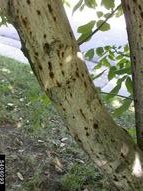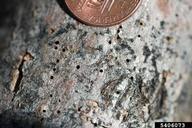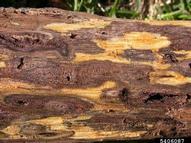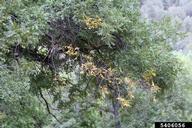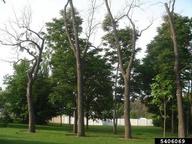Walnut twig beetle
Pityophthorus juglandis Blackman (Coleoptera: Curculionidae, Scolytinae)
Orientation to pest
The walnut twig beetle, Pityophthorus juglandis Blackman, is the vector of a newly recognized fungal species, Geosmithia morbida Kolarík, Freeland, Utley, and Tisserat (Ascomycota: Hypocreales). This insect-pathogen complex causes a fatal disease of eastern black walnut (Juglans nigra L.) and certain other species of walnut (Juglans). The common name for the disease is 'thousand cankers' because death results from the coalescing a great many small, separate cankers that originate at multiple points of twig beetle entry into twigs, branches, and main stems. Walnut twig beetle, a type of bark beetle native to the southwestern United States and parts of Mexico, is the only confirmed vector of the pathogen. In its early stages this disease appears as circular-to-oblong cankers that develop at the site of each walnut twig beetle gallery. Over time, cankers expand in the phloem, coalesce, and girdle twigs or branches. Geosmithia morbida does not move systemically within the tree and the pathogen is moved between trees only by the insect vector. Relatively large numbers of walnut twig beetles are needed to cause enough cankers to kill trees. The origin of this newly recognized pathogen is uncertain, but isolates from walnut species in the western United States show high genetic diversity, suggesting the fungus may be native to that region. Why the walnut twig beetle has recently increased to levels able to unleash a wave of walnut mortality is unknown, but is likely linked to its invasion of new parts of the country and attacks there on new species of walnut, some of which are highly susceptible. On black walnut in Colorado, the walnut twig beetle overwinters as adults in cavities excavated in the bark. Beetles colonize new hosts by attacking branches with rough bark, on the warmer side (exposed to sun). There are two overlapping generations per year in Colorado. Mass attacks are mediated by aggregation pheromones. Females dig oviposition galleries, inoculate with the galleries with their Geosmithia fungus, and then lay eggs along the gallery. Larvae emerge and dig tunnels, where they feed on fungus-infected wood.
Hosts commonly attacked
Trees that are highly susceptible to walnut twig beetle attack and fungal infection in the western United States include the California walnut (Juglans californica S. Wats.), Hinds walnut (Juglans hindsii [Jeps.] Jeps. ex R.E. Sm) (both native to California), and black walnut (J. nigra) (native only to the eastern United States). English walnut (Juglans regia L.) is moderately susceptible, while Arizona walnut (Juglans major [Torr.] A. Heller) - believed to be the original host for the beetle - appears to be quite tolerant. Two other important members of the walnut family - butternut (Juglans cinerea L.) and pecan (Carya illinoinensis [Wangenh.] K. Koch) - appear to be resistant to the pathogen.
Distribution
Walnut twig beetle and its associated pathogen are now reported from eight states in the western USA and three in the east (Tennessee, Virginia, and Pennsylvania). To what extent the western distribution reflects the native range versus recent spread into new locations is not certain.
| Figure 1. U.S. distribution of the thousand cankers disease (plus, one eastern location in Knoxville, Tennessee) |
Images of walnut twig beetle
| Figure 2. Adult of the walnut twig beetle, Pityophthorus juglandis | Figure 3. Piles of boring dust at entrance of points of adult walnut twig beetle attack | Figure 4. Adults of walnut twig beetles, in nuptial chamber | Figure 5. Egg gallery of walnut twig beetle |
| Figure 6. Larvae of walnut twig beetle | Figure 7. Galleries of walnut twig beetle in branch | Figure 8. Larva and pupa of walnut twig beetle, with a view of its fungal associate, Geosmithia morbida, which is sporulating profusely around the pupal cells. | Figure 9. Weeping wounds are signs of attack by walnut twig beetle on English walnut, Juglans regia. Symptoms on black walnut are different. |
| Figure 10. Emergence holes of walnut twig beetle | Figure 11. Cankers that have developed around the galleries of walnut twig beetle | Figure 12. Branch death and dieback are early symptoms of walnut twig beetle attack (seen here on Arizona walnut) | Figure 13. Black walnut trees dying or dead due to thousand cankers disease |
Important biological control agents related to this pest species
Natural enemies of walnut twig beetle have not been reported.
Web links for information on walnut twig beetle
- Pathway Assessment for Geosmithia sp. and Pityophthorus juglandis | USDA APHIS
- PowerPoint from California Forest Pest Council |
University of California & USDA Forest Service
Discusses host colonization behavior in California Hinds Walnut - Screening Aid for Identification | Cooperative Agricultural Pest Survey
- Fact Sheet | DontMoveFirewood.org | The Nature Conservancy
- Pest Alert | Colorado State University Extension
- Website from US National Forest Health Monitoring |
USDA Forest Service
Information and links about TCD and walnut twig beetle
Articles
- Tisserat, N., W. Cranshaw, D. Leatherman, C. Utley, and K. Alexander. 2009. Black walnut mortality caused by the walnut twig beetle and thousand cankers disease. Plant Health Progress. August 11, 2009. 10 pp.
- Grant, J. F., M. T. Windham , W. G. Haun, G. J. Wiggins, and P. L. Lambdin. 2011. Initial assessment of thousand cankers disease on black walnut, Juglans nigra, in eastern Tennessee. Forests 2: 741-748.
